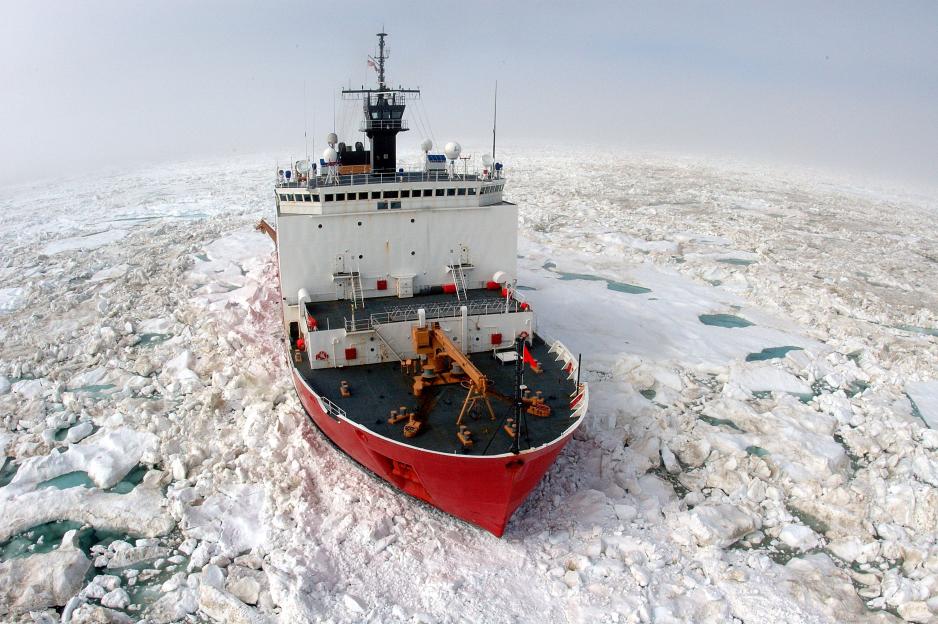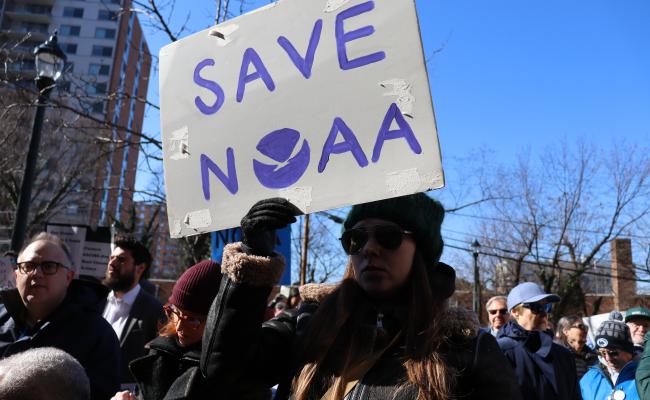Op-ed: A Quick Playbook for Congressional Oversight on Arctic Research

USCGC Healy in the Arctic. (Source: USCG/Petty Officer Prentice Danner)
Op-ed: It is clear that there are many Arctic research issues that warrant more engagement by the U.S. Congress, including potential non-compliance issues with statutory obligations, writes researcher Michael Walsh.
This is an op-ed written by an external contributor. All views expressed are the author's own.
The U.S. Congress has the power to conduct oversight of the executive branch on Arctic research. This can be achieved through the “the review, monitoring, and supervision of the implementation of public policy” related to Arctic research.
Over the last nine months, the Trump Administration has made some major changes to public policy related to academic research, including Arctic research. More appear to be on the horizon.
Those could prove to be far more consequential.
It is therefore deeply concerning that the U.S. Congress has not conducted more oversight to check the power of the executive branch, ensure that federal agencies are fulfilling their statutory obligations, and demand that federally funded programs are cost-effective and efficient in the context of Arctic research.
That is perplexing. It is clear that there are many Arctic research issues that warrant more engagement by the U.S. Congress, including potential non-compliance issues with statutory obligations.
Long before the Ottawa Declaration
Policy
There is a clear need to conduct oversight on the first duty of USARC articulated in The Arctic Research and Policy Act of 1984, as Amended (ARPA). The U.S. Arctic Research Policy was adopted by the Interagency Arctic Research Policy Committee (IARPC) back on 3 February 1986.
That was long before the Ottawa Declaration.
It was even before the fall of the Berlin Wall. A lot has changed in the world since the Reagan Administration was in power though. The Russian invasion of Ukraine serves as a case in point.
However, the U.S. Arctic Research Policy has not been regularly updated to account for those changes. That begs a couple of important questions:
- Is the current policy out-of-date?
- If so, should it be revised in the present context?
Also read (the text continues)
National Plan
There is a clear need to conduct oversight on the second duty of USARC and the fourth duty of IARPC articulated in ARPA. On 13 August 2025, USARC released a special report entitled, Research Needs for a Secure and Prosperous Arctic.
That special report merits closer scrutiny since it is intended to be one of the key inputs for the next version of the Arctic Research Plan.
Recent analysis suggests that the special report marks a major shift in the policy drivers and priority areas for Arctic research. That is because the special report not only reframes the needs for Arctic research almost exclusively around national security issues.
It limits the frame to economic security, military security, and societal security issues. As a consequence, it glosses over environmental security and political security issues. That begs an interesting question:
- Is the special report well-aligned with U.S. national interests?
It replaced the original version
Implementation Plan
There is a clear need to conduct oversight on implementation plans produced by IARPC. In May 2025, IARPC released the revised version of the Implementation Plan for the Arctic Research Plan (2025-2026).
It replaced the original version that was released by the Biden Administration a month before the Trump inauguration.
The revised version may not have been a complete rewrite, but it was a substantive revision.
Among other things, it replaced the overarching principle of “Inclusion and Equity” with “Fairness,” it dropped the community of practice termed "Diversity and Inclusion," and it changed the foundational activity objective of "Participatory Research & Indigenous Leadership in Research” to "Tribal Consultation and Effective Processes."
Interestingly, it did not simply simply supersede the prior version of the implementation plan. It superseded the Arctic Research Plan (2022-2026) itself. That begs a number of interesting questions:
- Is the Implementation Plan for the Arctic Research Plan (2025-2026) well-aligned with U.S. national interests?
- Should there be a duty for implementation plans articulated in Sections 104 and/or 108 of the Arctic Research and Policy Act of 1984, as Amended?
- Should President Donald Trump have had to notify the U.S. Congress of his intent to supersede the Arctic Research Plan (2022-2026) with the Implementation Plan for the Arctic Research Plan (2025-2026) in advance?
Also read (the text continues):
Goals and Objectives
There is a clear need to conduct oversight on the tenth duty of USARC articulated in ARPA. Per the statute, USARC is required to biennially publish a statement of goals and objectives on or before January 31st of that year.
The most recent report was released way back on 15 February 2023. That was the Goals and Objectives for Arctic Research (2023–2024). It was a noteworthy deliverable. No report had been released for the immediately prior two year period.
The last one was the Goals and Objectives for Arctic Research (2019–2020). These observations beg a number of interesting questions:
- Does Research Needs for a Secure and Prosperous Arctic effectively count as a substitute for the Goals and Objectives for Arctic Research (2025–2026)?
- Why did the Biden Administration fail to release the Goals and Objectives for Arctic Research (2021–2022)?
- Did the Trump Administration draft the document before the inauguration?
- If so, did the Biden Administration disagree with what was drafted?
- Why did the Trump Administration fail to release the Goals and Objectives for Arctic Research (2025–2026)?
- Did the Biden Administration draft the document before the inauguration?
- If so, did the Trump Administration disagree with what was drafted?
- Should the Trump Administration still release a Goals and Objectives for Arctic Research (2025–2026)?
Budget Support
There is a clear need to conduct oversight on the fifth duty of IARPC articulated in ARPA. Per the statute, IARPC is required to “provide the necessary coordination, data, and assistance for the preparation of a single integrated, coherent, and multiagency budget request for Arctic research.”
A number of important questions
This can be achieved through the production of a crosscut budget that presents budget information from all federal agencies whose activities are targeted at Arctic research.
It is known that the Biden Administration produced an Arctic Research Crosscut Budget Report (FY 2022-2024). It is unknown if a similar crosscut budget report was produced during the first term of the Trump Administration. That begs a number of important questions:
- Should the Trump Administration produce a new Arctic Research Crosscut Budget Report for the fiscal years associated with the Implementation Plan for the Arctic Research Plan (2025-2026)?
- Should there be a duty to produce a biennial cross-cut budget report articulated in Section 108 of the Arctic Research and Policy Act of 1984, as Amended?
Annual Reports
There is a clear need to conduct oversight on the seemingly repealed requirement that USARC provide an annual report to the President of the United States and U.S. Congress articulated in ARPA.
That report is supposed to articulate “the activities and accomplishments of the Commission during the immediately preceding fiscal year.” Note, there were reports produced for every fiscal year from 2002 until 2007.
Also read (the text continues)
However, none were published thereafter. That begs an important questions:
- Should there still be a duty to produce annual reports articulated in Section 104 of the Arctic Research and Policy Act of 1984, as Amended?
Concluding Remarks
Wherever Americans stand on the political spectrum, it is critical that their government makes the right choices on Arctic research to advance the national interests. Fortunately, the U.S. Congress has a wide array of options to conduct oversight of the executive branch on Arctic research.
One of the best known is hearings.
They not only provide a mechanism to “consider pending legislation” and “investigate and oversee federal programs.” They provide a platform for investigating “issues that may require legislation in the future.”
Start conducting more oversight on Arctic research
In those ways, they provide a way for legislators to “make better policy decisions” and impose “a system of checks and balances.” In the current session, some expect there to be a radical shift in policy drivers and priority areas for Arctic research.
It is therefore critical that individual members and relevant committees of jurisdiction start conducting more oversight on Arctic research. Otherwise, those shifts might not end up being in the national interest. Of course, increased oversight comes with its own risks.
One is that the oversight could be instrumentalized for political - rather than institutional and/or programmatic - purposes.
That is a fear of many Arctic researchers. It probably would not be in the national interest for oversight to be used for that purpose in the context of Arctic research. Consider the “un-American” hearings back in the 1950s.
A repeat could lead to the blacklisting of Arctic researchers in the United States. That outcome would quickly wipe away decades of investment by the U.S. government in Arctic research.
Michael Walsh is an Affiliated Researcher at the School of Foreign Service at Georgetown University.




